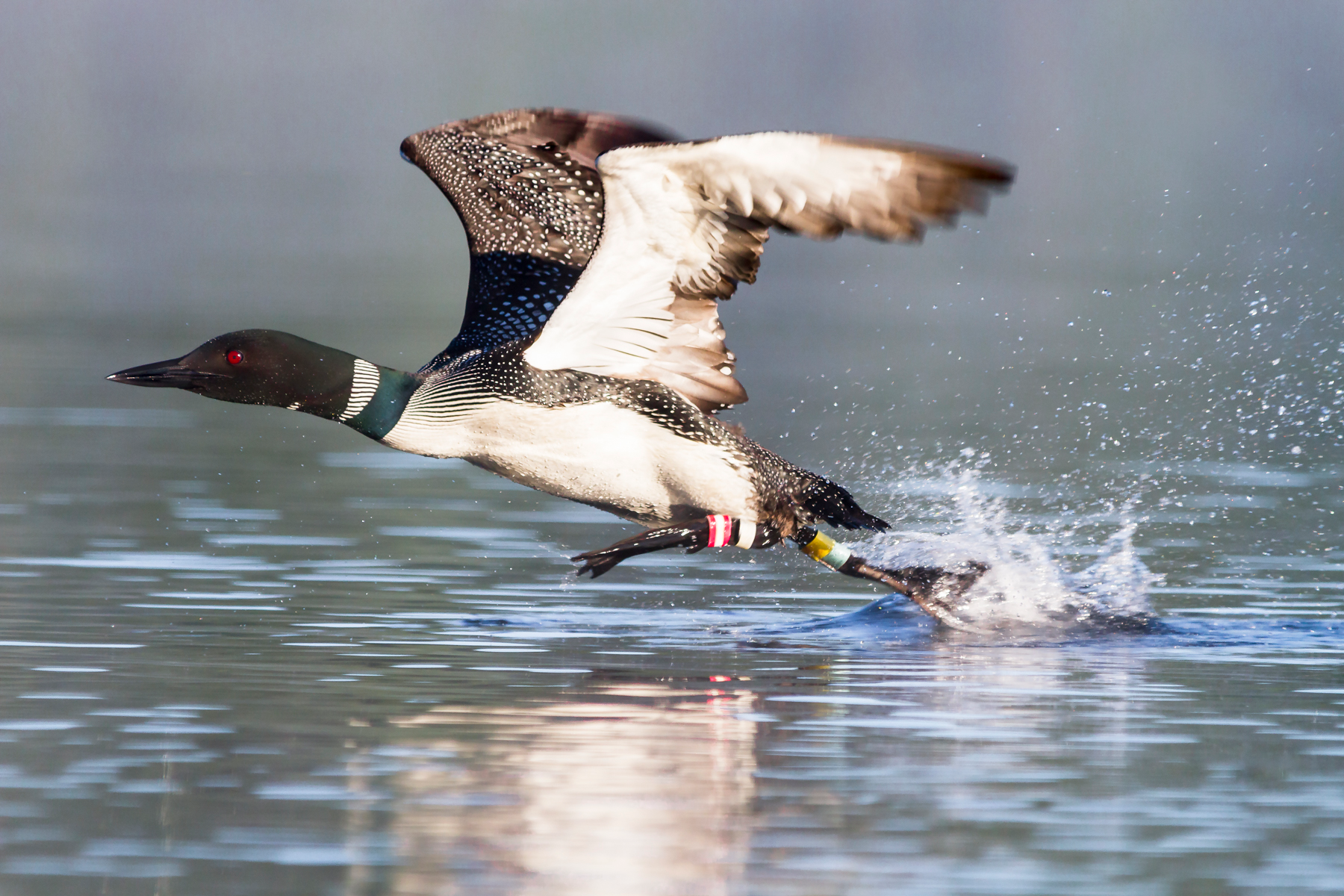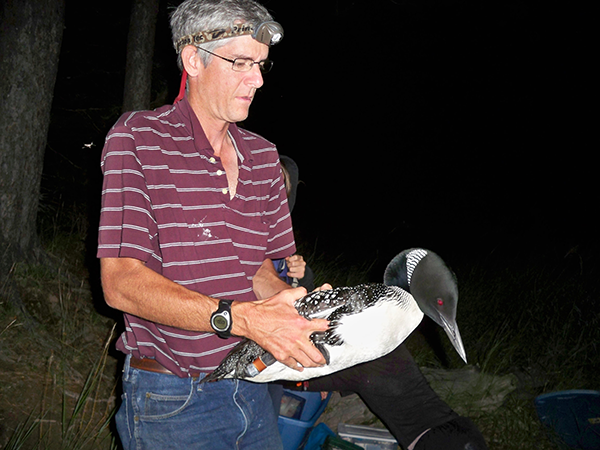By Walter H. Piper
Linked paper: Plunging floater survival causes cryptic population decline in the Common Loon, by Walter H. Piper, Jason Grear, Brian Hoover, Elaina Lomery, Linda M. Grenzer, The Condor: Ornithological Applications.
In the excitement and confusion of all-night loon capture, you don’t have much time to think. With a goal each night of catching five lakes’ worth of loons, your team of four loon researchers works steadily and by routine. Scan the lake with a powerful spotlight, find the loons, capture adults and chicks safely, place bands on their legs, weigh and release them, and proceed to the next lake. The team takes few breaks during the short July nights in northern Wisconsin. One loon territory blurs into the next.
Yet it was during the blur of nocturnal loon capture—an annual ritual that began in 1993 and continues to this day—that I first noticed the change. Where are the huge chicks we used to see? I muttered to myself from time to time during the early 2000s. As the years passed, and the pattern grew more evident, my mutterings became more of a pronouncement: “Chicks just aren’t as big as they used to be.” Finally last year, I decided to act upon my growing sense of dread. I interrupted my study of loon territorial behavior to analyze the health and stability of the Wisconsin loon population.
I don’t think you ever expect to see your study animal fall into long-term decline. Since my time as a child vacationing on Lake Temagami in central Ontario, I have associated the haunting nocturnal calls of loons with the soft lapping of waves on rocky shorelines and the rich aroma of balsam firs. I have always viewed loons as essential and eternal members of boreal lake communities. I am not alone. Across Canada and the northern United States where they breed, Common Loons are conspicuous and beloved animals. Cottagers on my study lakes in Wisconsin adore “their” loons and protect them fiercely. After all, they drive six hours from Chicago to northern Wisconsin to fall asleep among the redolent, whispering balsam firs while listening to loon cries echoing across the water.
As both a lover of loons and a scientist, I have found it doubly alarming to learn that the loon population of northern Wisconsin is declining. My gut feeling from capture that chicks have become smaller over the past quarter century was confirmed statistically, but that was only one of several pieces of bad news. More worrisome were our findings that, compared to the late 1990s, 31% more chicks now perish before they reach five weeks, and 82% more chicks die after reaching five weeks of age.
Our most shocking result, however, was our discovery that the population of young adult floaters had plummeted to less than half of its size in the 1990s. Floaters are three-to-eight-year-old loons that live on the fringes of the territorial population and wait for an opportunity to settle by replacing a dead territorial owner or evicting one after a prolonged battle. These young adults constitute a vital population segment; they are future breeders. So a loss of floaters signals that a population may have trouble sustaining itself. In fact, our population model projects a decrease of 6% annually in the northern Wisconsin loon population as a result of the declines in loon survival we have measured. If the model is correct, we will see a loss of roughly one-third of all loon breeding territories in northern Wisconsin by 2031.
Studies of loons routinely count numbers of territorial pairs as a way to measure the health and stability of the population in a certain region, but they do not count floaters. Floaters are, in effect, a hidden population component, because measurement of floater populations depends upon long-term marking of chicks and monitoring of territorial intruders, which have not occurred outside of our northern Wisconsin study area. A paper published this year has documented reproductive declines—parallel to those we found—in the heart of the loon breeding range in Ontario. Could this signal a downturn in floater numbers in Ontario as well? At present, we lack the data necessary to answer this critical question. In fact, we cannot know for certain if Common Loon populations in Quebec, Maine, Manitoba, and elsewhere face imminent declines owing to losses of floaters. But if they do, many vacationers on northern lakes will soon fall asleep to the smell of balsam fir and the sound of waves along the shoreline, but without the loon’s cherished and soothing nocturnal lullaby.



Two thoughts come to mind through personal observation.
The lake I reside on in far northeast Wisconsin, for the last five years, the water levels have been at their highest point than in the previous twenty. A few of the old nesting sights are still available but many now are flooded or underwater come ice off.
The second item that seems to have become much more prevalent is the amount of black fly infestation on the nesting sight. The problem has gotten so bad, that the loons are forced to abandon the nest after the typical two eggs are laid, causing a loss of incubation. Last year, after abandonment, the loons did not even attempt a second nest, highly unusual.
One other thing that happened last year for the first time. The loons left in August, roughly three weeks apart from each other. Their normal departure is late September or early October and relatively at the same time.
Twenty years of observation does not make a study complete but patterns do start to present themselves, even in that short span of time.